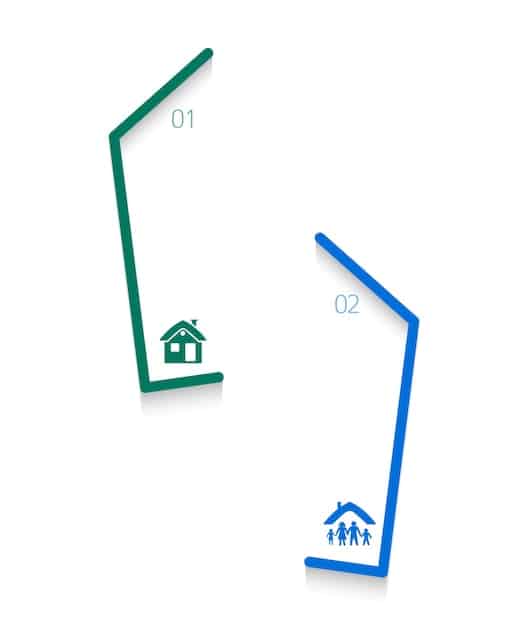Itemizing vs. Standard Deduction: Your Tax Strategy for 2025

Itemizing versus the standard deduction is a critical decision for taxpayers when filing their taxes, impacting the amount of taxable income and potential tax savings; understanding both options and how they apply to your financial situation is crucial for tax planning in 2025.
Deciding between itemizing vs. standard deduction can significantly impact your tax liability. As we look ahead to 2025, let’s explore which approach could save you more money.
Understanding the Standard Deduction in 2025
The standard deduction is a fixed dollar amount that reduces your taxable income. It simplifies the tax filing process, as you don’t need to track specific expenses.
For many taxpayers, especially those with simpler tax situations, the standard deduction offers a quick and easy way to lower their tax burden.
2025 Standard Deduction Amounts
The standard deduction amounts are adjusted annually for inflation. While the exact figures for 2025 won’t be available until late 2024, we can look at the 2024 amounts for reference:
- Single: $14,600
- Married Filing Separately: $14,600
- Married Filing Jointly: $29,200
- Head of Household: $21,900
- Qualifying Surviving Spouse: $29,200
These amounts are expected to increase slightly for 2025. Taxpayers who are age 65 or older or who are blind get an additional standard deduction amount.
Who Should Consider the Standard Deduction?
The standard deduction is generally the better choice if your total itemized deductions are less than the standard deduction amount for your filing status. It simplifies tax preparation and can save time.
Many people who rent, have minimal medical expenses, and don’t make significant charitable contributions find that the standard deduction is the most advantageous option.

What Does It Mean to Itemize Deductions?
Itemizing deductions involves listing out individual expenses that you can deduct from your taxable income, instead of taking the standard deduction.
This approach requires more effort and record-keeping, but it can result in significant tax savings if your deductible expenses exceed the standard deduction.
Common Itemized Deductions
Several expenses can be itemized on your tax return. Here are some of the most common:
- Medical Expenses: Expenses exceeding 7.5% of your adjusted gross income (AGI)
- State and Local Taxes (SALT): Limited to $10,000 per household
- Home Mortgage Interest
- Charitable Contributions
- Casualty and Theft Losses (in federally declared disaster areas)
Each of these deductions has specific rules and limitations, so it’s essential to understand the requirements before claiming them.
Who Should Consider Itemizing?
Itemizing is typically beneficial for taxpayers who have significant deductible expenses. For example, those with high medical bills, substantial mortgage interest, or large charitable donations may find that itemizing results in a lower tax liability.
Taxpayers who live in states with high state and local taxes may also benefit from itemizing, although the SALT deduction is capped at $10,000.
In conclusion, understanding the nuances of itemized deductions is crucial for those seeking to optimize their tax strategy and potentially reduce their overall tax burden.
Navigating the $10,000 SALT Deduction Cap
The State and Local Tax (SALT) deduction allows taxpayers to deduct certain state and local taxes from their federal income tax. However, this deduction is capped at $10,000 per household.
This limitation has a significant impact on taxpayers in high-tax states, potentially reducing the benefits of itemizing.
Understanding the SALT Cap
The $10,000 SALT cap includes the following:
- State and local property taxes
- State and local income taxes (or sales taxes, if you choose to deduct sales taxes instead of income taxes)
If your combined state and local taxes exceed $10,000, you can only deduct up to that amount.
Strategies for Managing the SALT Cap
While the SALT cap limits the deduction, there are strategies taxpayers can use to minimize its impact:
- Time Tax Payments: Strategically time your tax payments to maximize your deduction within the $10,000 limit.
- Consider Bunching Charitable Contributions: Bunching can help you exceed the standard deduction in alternating years.
These strategies can help taxpayers maximize their deductions despite the limitations.
Ultimately, the SALT deduction cap impacts many taxpayers, particularly those in high-tax states, making tax planning even more critical.
Medical Expense Deductions: What You Need to Know
You can deduct medical expenses that exceed 7.5% of your adjusted gross income (AGI) if you itemize deductions.
This deduction can be a significant benefit for taxpayers with high medical costs, helping to reduce their taxable income.
What Qualifies as a Medical Expense?
The IRS defines medical expenses as costs for the diagnosis, cure, mitigation, treatment, or prevention of disease, or for the purpose of affecting any structure or function of the body.
Examples of deductible medical expenses include:
- Payments to doctors, dentists, and other medical professionals
- Hospital services
- Prescription drugs
- Insurance premiums (including Medicare)
- Long-term care services
However, certain expenses, such as cosmetic surgery and non-prescription drugs, may not be deductible.
How to Calculate the Medical Expense Deduction
To calculate the medical expense deduction, you must first determine your AGI. Then, calculate 7.5% of your AGI. Finally, subtract that amount from your total medical expenses.
The resulting figure is the amount you can deduct on Schedule A.

Home Mortgage Interest: A Valuable Deduction
Homeowners can deduct the interest they pay on their mortgage, up to certain limits.
This deduction is a valuable benefit of homeownership, helping to reduce the overall cost of buying and maintaining a home.
Understanding the Home Mortgage Interest Deduction
Taxpayers can deduct mortgage interest on the first $750,000 of mortgage debt (or $375,000 if married filing separately) if the debt was used to buy, build, or improve their home.
This limit applies to homes purchased after December 15, 2017. For mortgages taken out before that date, the limit is $1 million (or $500,000 if married filing separately).
How to Claim the Deduction
To claim the home mortgage interest deduction, you’ll need to itemize deductions on Schedule A.
You’ll typically receive Form 1098 from your mortgage lender, which shows the amount of interest you paid during the year. Use this form to calculate your deduction.
Understanding the home mortgage interest deduction can significantly reduce the cost of homeownership, making it a valuable tax benefit to consider.
Charitable Contributions: Giving Back and Saving on Taxes
Taxpayers can deduct contributions they make to qualified charitable organizations, helping both the charities and their own tax liability.
This deduction encourages charitable giving and can result in significant tax savings for those who itemize.
What Qualifies as a Charitable Contribution?
To be deductible, a charitable contribution must be made to a qualified organization, such as a 501(c)(3) nonprofit.
Examples of deductible contributions include:
- Cash donations
- Donations of property, such as clothing or household goods
- Unreimbursed expenses incurred while volunteering for a qualified organization
However, you cannot deduct the value of your time or services.
Limits on Charitable Contribution Deductions
The amount you can deduct for charitable contributions is generally limited to 60% of your AGI for cash contributions and 50% of your AGI for contributions of property.
These limits may be further reduced in certain situations, so it’s important to understand the rules before claiming the deduction.
In summary, charitable contributions offer a great way to support causes you care about while also potentially reducing your tax liability.
| Key Point | Brief Description |
|---|---|
| 💰 Standard Deduction | Fixed amount, simple, good for those with few deductions. |
| 🧾 Itemized Deductions | Listing individual expenses; beneficial with high deductions. |
| 🏘️ Home Mortgage Interest | Deduct interest paid on a mortgage up to certain limits. |
| ⚕️ Medical Expenses | Deduct expenses exceeding 7.5% of your AGI. |
Frequently Asked Questions
▼
The standard deduction is a fixed amount that reduces your taxable income. Itemizing involves listing individual deductible expenses, potentially reducing your tax liability if those expenses exceed the standard deduction.
▼
You should choose to itemize if your total deductible expenses, such as medical costs, mortgage interest, and charitable donations, exceed the standard deduction amount for your filing status.
▼
Common itemized deductions include medical expenses exceeding 7.5% of your AGI, state and local taxes (SALT) up to $10,000, home mortgage interest, and charitable contributions to qualified organizations.
▼
The SALT deduction cap limits the amount of state and local taxes you can deduct to $10,000 per household, which may reduce the benefits of itemizing, particularly in high-tax states.
▼
Yes, the standard deduction amounts are adjusted annually for inflation. While the exact figures for 2025 won’t be available until late 2024, they are expected to increase slightly from the 2024 amounts.
Conclusion
Deciding between itemizing and taking the standard deduction requires a careful evaluation of your financial circumstances. By understanding the factors discussed above, you can make an informed decision that optimizes your tax outcome for 2025.





